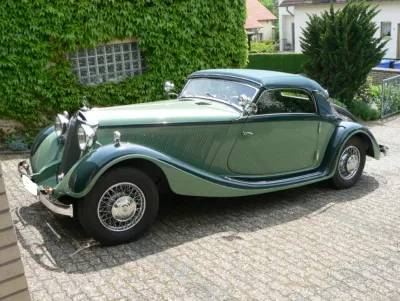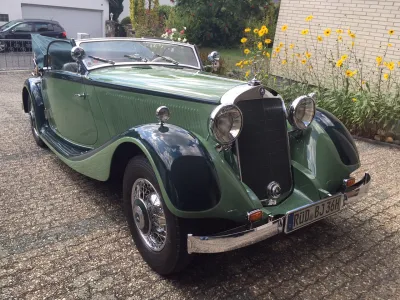Collection
The effects that World War II had on pre-war manufactured Mercedes Benz automobiles would not be realized for decades. Not only were the majority of the W18 or 290 Models cars destroyed or lost during the war, but the factory in Mannheim, Germany where this W18 was built, was completely incinerated by the Allies at the close of the war. All records and documentation, specifically build sheets relating to cars built at this plant were destroyed in the inferno. Only owner’s manuals, sales literature and parts manuals survived the war.
This Cabriolet A was located by Mercedes Benz Classics Center, Irvine, CA., and authenticated by Christian Kramer a FIVA/HVA certified appraiser. Nonetheless, the task of authenticating this car was daunting. Fortunately, Mercedes Benz, Germany had records of the car being serviced in the early 1970's as a Cabriolet A with a Sindelfinger Karoserie body. That record established that the body was true to the chassis. In the 1970’s, the collector interest and value of a 290 was such that it would be unlikely that the car would have been "rebodied." In addition, this car has both a FIVA and a Deuvet certification of authenticity.
This 290 Cabriolet A was manufactured in 1936. However, it was not sold to its first owner until 1948 giving conjecture that the car was hidden away during the rise of the Third Reich and World War II. The car has had the following owners:
- Fa. Cassella, Farbwek, Mainkur 1948 – 1975
- E.D. Harris, Germantown, PA USA 1975 - 1995
- Ferdinand Schaefer, Walluf, GR 1995 – 2015
- Valerie & Aaron Weiss, San Marino, CA 2015 - Present
There is no argument that the W18 was a “mid-price point” car. Mercedes-Benz manufactured the high end 380, 500 and 540K luxury models and a 170 and a 230 economy model. Nonetheless, wealthy buyers wanted the 290 model as it was not ostentatious. Wanting to personalize the cars, many were special ordered, resulting in a large number of iterations making few cars “standard.”
Mercedes-Benz produced 7,495 W18 (290) passenger cars, of which 3,566 sat on the shorter chassis while 3,929 including this car, used the longer 3,300mm/130-inch wheelbase. The car was outfitted with a straight six engine of 2.867-liters with 68 horsepower and four-speed transmission. The German auto-market in the middle 1930s absorbed roughly 200,000 passenger cars annually. In its strongest years (1934 and 1935) the W18 was selling at the rate of approximately 2,000 cars annually implying a market share of very roughly 1%.


